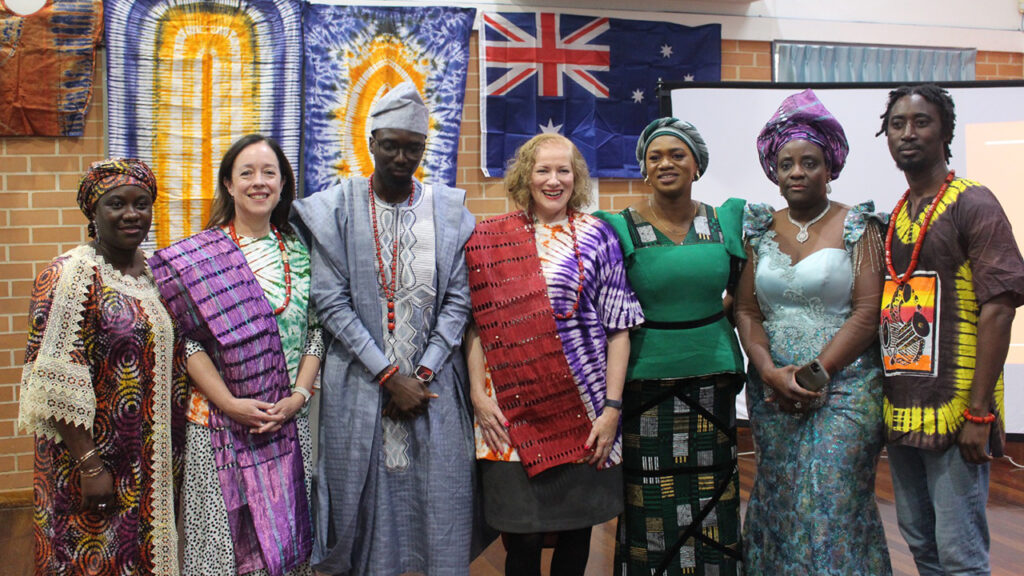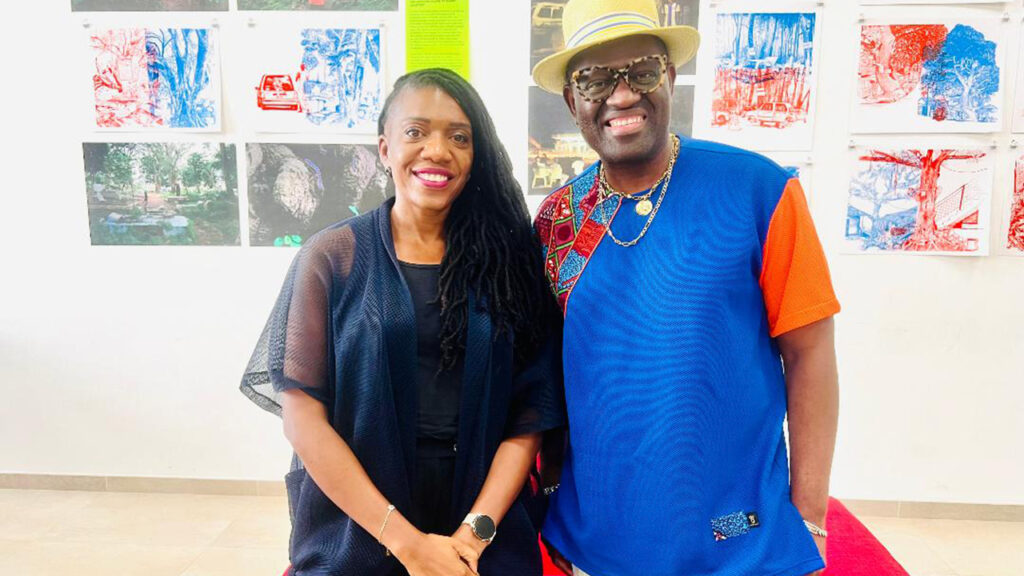
Chinyere Akachukwu is a self-taught artist and a trained lawyer. She is creating a niche for herself through her eye-catching, thought-provoking expressions that document the society, behaviours and norms and invites her audience to take a deeper look into these events as a potential agent for change.
Inspired by God, as she says, her journey into creating art pieces started in 2015 while she was studying in Birmingham. In 2015, on a random afternoon, as a university student in Birmingham, she was overcome by an urgent feeling to do more with my life and be more in life.
“I had always loved drawing; however, I had never painted before. I also had not had a painting lesson prior but I knew I could paint even before I did,” she retorts.
According to her, “the pull to create felt so urgent that I made up my mind instantly and started then and there (this was not in an impulsive way) that I wanted to create art. Honestly, it was God’s time for me to put all that I had within me on canvases for the world to see. That was how I started creating acrylic paintings. That afternoon in 2015, it felt like I got a call to use God’s gift (to me) to create for the world (and possibly fulfil my name, which means – God’s Gift (Chinyere) – Hand of God (Akachukwu )). I also thought a lot about the biblical parable of the talents. This parable was very instrumental in my direction and drive.”
Her show, These Resent Times, held at Miliki, Victoria Island in October 2021, was a launch pad to the country’s art space, as she showed work that documents her immediate society as well as the world around her. The entire body of work focused on social issues and she was careful to stay on just one side of it throughout the conceptualisation and execution.
A lover of Paul Gauguin’s paintings in her new collection of paintings titled, The Kids Are Not Alright, she documents the country’s recent history. The works are intended to serve not just an aesthetic purpose, but also as a forum for contemplation and reflection.
The Journey Begins is a part of the Little Green Riding Hood Series. This series is inspired by the story of a young girl who traveled dangerous woods to visit her grandmother and was eventually eaten by a wolf.
“The Journey Begins tells the story of young un-chaperoned children who make their way to school or elsewhere every day. It seeks to draw to the viewer, the dangers that can follow unsupervised children, which seems to be accepted by society,” she says.
The figures start their journey across a blue nothingness, which could be skies or rivers. The skies represent abundance of limitless knowledge they travel by. It also represents fatal falling to the harsh grounds. The rivers represent abundance and life. It also represents imminent dangers of drowning that the two figures seem oblivious to. The daily trips teach the figure in ways they may not learn in a conventional classroom set up, “but at what cost?” Akachukwu asks.
The painting also shows the responsibility young children are sometimes given. Older children are often tasked to look after or babysit their younger ones. In reality, this is dangerous as they are still all children who should be taken care of and not the other way around.
This piece is also a reminder of the kidnapping of Chibok school girls, which led to the Bring Back Our Girls movement. In Little Green, this painting continues to follow the story of the two un- chaperoned prepubescent girls who make their way on their quest for higher education. The painting shows the girls in the middle of the busy highway presumably after crossing it by themselves the speeding cars and the accident, which occurred behind them.
It shows them approaching a Keke NAPEP tricycle. The artist also seeks to highlight the state of some of the roads in parts of the country by the potholes in the painting.
“In these recent times, certain locales are unsafe; it is, therefore, a surprise that it is common to see un-chaperoned young children making long daily trips to schools. The country has also seen dark days in relation to the state of security of its children. The “bring back our girls” is still an unsettled matter, yet every weekday morning, when schools are in session, unaccompanied little children still travel through the roads in pursuit of education,” she says.
The blame is not on the parents of the children, as people don’t let their beloved into unsafe terrains if they had an alternative. Despite the sad times that followed the kidnapping of the Chibok girls, the cruel fate is that life has to go on in the hopes that history will not repeat itself.
The stifling daily fear of the parents is that their beloved just like red riding hood do not get followed and attacked by the big bad wolf at their final destination.
The two girls’ journey continues in The Forest, as they enter into a metaphorical ‘forest’ enclave. The artist shows the dangers of daily journeys by little children, which are ignored owing to the poor circumstances of parents of the children. The forest signifies the regular environment in Nigeria. “The forest also represents the physical forests in the country, which is an unchecked safe haven for ritualists, depraved persons and kidnappers alike,” the artist reveals.
The artist seeks to emphasise how little children daily toy with falling prey to miscreants. News of victims of kidnappings and rituals grace pages of newsapers, yet not much is done to combat this issue. She seeks to draw reference to the kidnapping of the Chibok girls and hiding in the forest.
The Witnessing is also a poignant statement in the artistic exploration of Akachukwu. Choosing a topical issue as ritual killing or sacrificial killing, she laments the state of the nation. “Some men, women and children alike are targets of bad people who seek to kill them for occult rites,” she says.
In this piece, the artist wishes to paint a picture of an unfortunate ritual killing by a group of men, which the two girls sadly witness from a distance.
The girls are fortunately observing the act while hidden in the forest. There is an open car with splashes of blood on parts the pothole filled bad road, which the viewer can decipher, belongs to the burning victim.
The victim’s body is engulfed by blazing flames whilst the unknown men walk around the burning body with torches in a circle to denote occult practice. The artist also seeks to address the recent lynchings and mob attacks by persons who without empathy or emotion are quick to snuff the life out of others who they perceive to be deserving of the capital punishment. The Witnessing is a very dark piece showing the dangers of an unchecked society, which could only get darker if allowed to.
Dam, It’s Rained All Year Round addresses climate change. In 2022, Nigeria’s plain Jane weather which was once as sure as day dramatically changed. What followed was frequent rain through most of both the dry and rainy season.
The piece seeks to address how climate change has affected the country and resulted in loss of properties and lives. The piece also seeks to address the dam problem Nigeria has been plagued with in the past years.
The Lagdo Dam in Cameroun, which allegedly releases water, which is rumoured to spill into Nigeria as Cameroun borders Nigeria. The water release allegedly leads to flooding of parts of Nigeria. It is hoped that the Nigeria Dasin Hausa Dam will be completed to help alleviate this flooding problem in northern Nigeria. Unfortunately, the steps being taken to combat these problems seem to be slow. The piece at its core shows what unpreparedness and disregard looks like. The piece further shows the hardships most have to endure owing to climate change as well as the flooding.
In The Abduction, the artist addresses security issues in the country as well as child trafficking and kidnapping as well as other woes of a poor economy. The artist wishes to continue the conversation of security initiatives being set up to protect not just young children but adults as well. “I think we have a plastic problem the girls are on their journey and one of their stops is past a refuse dumpsite, which has formed a shocking mound of plastic garbage beside an institution and a bus stop,” she says.
The artist uses layers of acrylic paint, moulding paste and granular gel to create the illusion. In the piece, the artist seeks to address the plastic problem that is evident in indiscriminate refuse dumping but even more, the plastic problem which the whole world is battling.
The plastic problem is a real issue as efficient steps are not being taken to combat and manage the issue. Plastic waste has also been attributed to water contamination, death of sea and land creature as well as health issues in human through food contamination.
The girls walk past the refuse dump seemingly unfazed. The vehicles and hawkers are also unbothered. It appears that the vehicles have also destined the site of the unsightly refuse dump to be a bus stop to pick up passengers.
This highlights the nonchalant attitude of most towards this plastic problem. The plastic problem has unwittingly become a part of the normal. It is clear that most have passed this site so many times before unfazed. The need for recycling is a present but often times ignored as a lot of the population have not been sensitised to the need to adopt recycling as the new order
By Chance tells a story of the two school girls encountering two other girls (and a baby) of about the same age, the other girls are beggars and one of the beggar girls is carrying a baby girl. She has clearly been tasked with the responsibility of caring for the little one even though she is merely a child herself. The painting seeks to invite the viewer to reflect on how life is a game of chances and divine grace. None of the girls asked to be where they were. They were simply born into their circumstances. By Chance seeks to leave the viewer with a feeling of empathy and realisation that chance and grace are constantly at play.
The artist also decries the parental responsibility being put on young children due to their guardians’ poor choices or unfortunate circumstances. the artist further decries society’s failure to put in place and insist on proper family planning or child protection services which would go a long way in protecting Nigeria’s future (generation).













